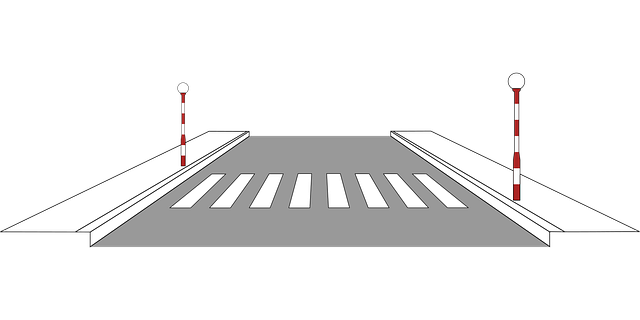Enhance road safety by staying vigilant of hazards like winding roads and weather changes, especially for elderly drivers. Implement traffic calming measures at home and follow highway exit strategies. Use Defensible Space Design to protect against dangers like intersections and construction sites. Educate communities through workshops on defensive driving and rules. Collaborate with local governments for improved signposting and awareness programs. Stay informed about local conditions and connect with community initiatives for tailored Select Road Safety Tips.
In today’s fast-paced world, ensuring road safety within your community is paramount to preventing accidents and saving lives. This article equips you with a comprehensive set of risk reduction strategies, focusing on defensible space design, traffic calming measures, community education, and collaboration with local authorities. By implementing these select road safety tips, you can create a safer environment for everyone, fostering a sense of security and peace of mind.
- Assess Your Environment: Spot Potential Hazards
- Implement Traffic Calming Measures at Home
- Practice Defensible Space Design for Safety
- Train and Educate Your Community Members
- Collaborate with Local Authorities: Stay Informed
Assess Your Environment: Spot Potential Hazards

Before you can effectively defend your space and reduce risks, it’s crucial to understand your surroundings. Assessing your environment involves being vigilant for potential hazards that could pose a threat to your safety. When driving, take note of factors like road conditions—are they narrow or winding? This calls for heightened caution and adherence to specific road safety tips designed for navigating such terrains safely. Also, be alert to unexpected obstacles, weather changes, and the behavior of other drivers around you.
For elderly drivers, additional safety considerations come into play. They might need more time to react to sudden situations due to various factors. Thus, it’s important to anticipate their needs and allow sufficient space for them on the highway. Being proactive in identifying and addressing these hazards is a key element of defending your space and ensuring that emergencies on the highway are handled with efficiency and safety.
Implement Traffic Calming Measures at Home

Implementing traffic calming measures at home is a proactive step to reduce risk and defend your space. Start with evaluating your property’s external layout, considering options like speed bumps, reduced speed limits signs, and road markings to discourage excessive speeding. These simple yet effective tools can significantly enhance road safety, particularly for children playing nearby or pedestrians crossing the street.
Additionally, integrating highway exit strategies for quick evasive maneuvers into your routine can further bolster safety. Teaching residents about bicycle safety rules for kids ensures everyone’s well-being on two wheels. Similarly, promoting safe driving practices after consuming alcohol or drugs is paramount to prevent accidents and protect lives within your community.
Practice Defensible Space Design for Safety

Implementing Defensible Space Design is a powerful strategy to enhance your safety, especially in potentially hazardous areas. This concept revolves around creating physical and environmental barriers to mitigate risks and protect against unexpected dangers. By designing your space with this principle in mind, you can significantly reduce the likelihood of accidents or harmful incidents. For instance, well-placed barriers, guardrails, and signage can act as a buffer zone, providing a safe distance between moving vehicles, pedestrians, and potential hazards like construction sites or busy intersections.
When adopting these road safety tips, consider the overall layout and accessibility of your surroundings. Select and place objects strategically to create defensible spaces, ensuring smooth traffic flow and clear visibility. Additionally, integrating features that promote calm and controlled movements can help prevent accidents. Remember, the goal is to make your space predictable and safe, especially for vulnerable road users, while also considering the practical aspects of everyday life, such as access for emergency vehicles and maintaining roadside assistance essentials.
Train and Educate Your Community Members

Community education is a powerful tool in risk reduction. By training and educating your community members about road safety tips, you’re fostering a culture of awareness and accountability. Organize workshops or seminars to discuss topics like defensive driving techniques, low-light visibility enhancement, and navigating busy city streets safely. Teach them the importance of maintaining their vehicles, including regular tire checks and changes, especially on highways where risks can be elevated.
Encourage community members to share these road safety practices with their peers. Word-of-mouth education can significantly impact reducing risks while changing tires on highways or driving in low-light conditions. Emphasize the value of staying alert, following traffic rules, and being prepared for unexpected situations—all essential aspects of managing potential hazards on our roads.
Collaborate with Local Authorities: Stay Informed

Collaboration with local authorities is a cornerstone in enhancing road safety. By staying connected and informed about community-specific risks, you can implement tailored road safety tips that cater to unique challenges like narrow or winding roads. Many regions offer resources for navigating such terrains safely, from signposting improvements to community awareness programs. Staying attuned to these initiatives ensures everyone’s security on the roads.
Additionally, keeping abreast of local conditions, especially after natural disasters or during seasonal changes, is vital. For instance, driving precautions in flooded areas are essential, as are safe practices after consuming alcohol or drugs. Local authorities often disseminate time-sensitive information and guidelines through various channels, ensuring citizens can make informed decisions to mitigate risks on the roads.
By implementing these comprehensive road safety tips, such as assessing your environment, adopting defensible space design principles, training community members, and collaborating with local authorities, you can significantly reduce risks and create a safer living space. Remember, active participation in traffic calming measures at home and community education are key to navigating a safer neighborhood. Stay informed and adapt these strategies to suit your unique environment for optimal results.
